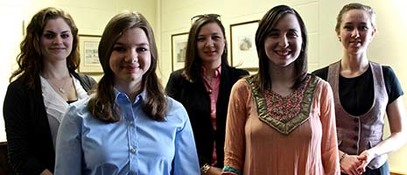Students Impress at Annual Medieval Institute Undergraduate Colloquium
 Kathleen Davin, Erica Sestak, Crystal Chen-Goodspeed, Karen Neis, Olivia Bratton (from left to right)
Kathleen Davin, Erica Sestak, Crystal Chen-Goodspeed, Karen Neis, Olivia Bratton (from left to right)
On Saturday, April 9th, five Notre Dame undergraduates presented medieval studies-inspired papers with the support of the Medieval Institute’s Director of Undergraduate Studies, Linda Major, organizer of this annual colloquium. Participants were chosen based on outstanding papers they wrote on medieval topics in the past year.
Olivia Bratton (Senior, College of Arts & Letters) argued for photography as within the realm of liturgical art in the object tradition of the Catholic Church in “Sacred Photography as Based on Medieval Iconic and Relic Traditions.” According to Bratton, “Pieces such as the Shroud of Turin and the Veil of Veronica dwell in the borderland between relic and icon, providing technical and practical precedent for both extant photographs and photographs being made today. By understanding both the practice and the theology of icons and relics, we can understand how to incorporate photography into sacred settings.”
Next, Karen Neis (Senior, College of Arts & Letters), exhibited her impressive 32-page fully-illustrated children’s book Abul Abbas the Elephant: Gift to Charlemagne, which tells the story of the elephant the Persian emperor Hârûn al-Rashîd sent from Baghdad to Charlemagne in Aachen around the year 801 A.D. with the help of Charlemagne's emissary Isaac (read more about this historical event, which is related in Einhard's Life of Charlemagne). In her beautiful illustrations, Neis incorporates elements from medieval art, such as textiles, wall-paintings, a vase, and manuscript illuminations.
Following a lunch break, Erica Sestak (Freshman, First Year Studies), problematized the character of Robin Hood’s daughter Gwyn in Princess of Thieves, arguing that while, as she notes, the movie “attempts to portray Robin Hood’s daughter Gwyn as an independent and strong woman, she remains a passive, feminine character for a modern audience as she follows the precedent set by other [Disney] ‘princesses.’ However, as she also follows the pattern set by transvestites in the Middle Ages, Gwyn is accurately portrayed as an independent, strong female character within the realm of the medieval era, despite her dependency on men throughout the film.”
Kathleen Davin (Sophomore, College of Science) compared Elaine of Astolat of Thomas Malory’s medieval Le Morte D’Arthur and Lisa Ann Sandell’s modern retelling Song of the Sparrow in “For Love of Lancelot: Elaine of Astolat's Quest for Self-Definition.” Ultimately she showed how “Sandell amplifies the strengths already present in Malory’s complex Elaine to carry out her avowed purpose of giving Elaine a chance to tell her own story.”
Finally, Crystal Chen-Goodspeed (Senior, College of Science), in “Robin Hood and the Hunger Games,” posed the question of what the two have in common. She remarked first on their expansive differences—time period, location, gender of the protagonists, and general story line—but then presented a strong case that “upon closer comparison we may be able to conclude that Robin Hood is the literary ancestor of The Hunger Games' Katniss Everdeen due to similarities in setting, social hierarchy, fight against the wealthy for the sake of the poor, and supporting cast such as Maid Marian and Peeta, the Baker's Boy (or is it really Maid Peeta?).”
All did a marvelous job; we offer a hearty thanks as well to Linda Major for her organization of another stimulating program.